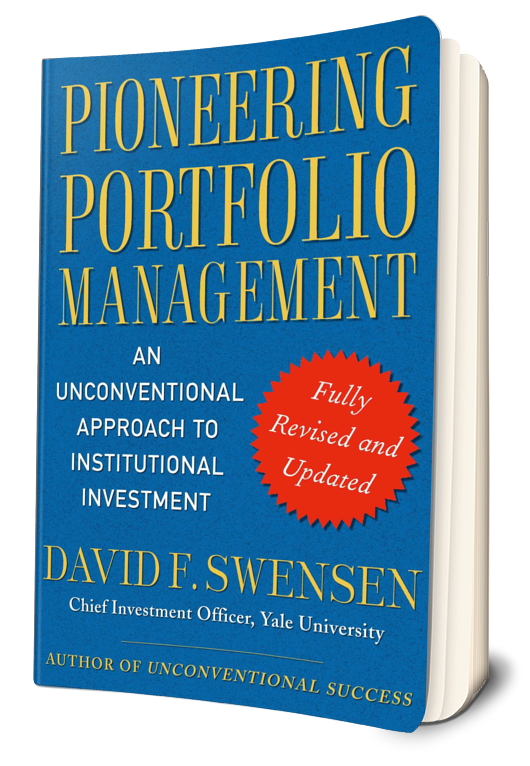The financial book Pioneering Portfolio Management covers topics including institutional investments, asset classes, securities management, and how to modify a portfolio based on risk, a diversified investing strategy, and overall asset allocation.
Pioneering Portfolio Management by David F. Swensen is a must-read if you want to improve your investment strategy, regardless of whether you’re an individual investor just beginning your journey, someone who has some experience in the industry, or someone who manages money at an institutional level.

This book covers everything, from the value of endowments to the significance of asset allocation to the long-term policies an institution must adopt if it wants to be financially successful over the long term. Most importantly, this overview will clarify the 21st-century investment philosophy, according to which an organization’s strategy is only as effective as the financial needs it can satisfy.
Endowments are typically a component of an institution’s effective long-term plan
Numerous organisations have endowments that guarantee their long-term viability, including public institutions, universities, colleges, charities, trusts, and even NGOs. An endowment is a gift that an institution receives from a person or another institution that must be preserved in the possession of the recipient organisation for as long as they are in operation.
Although an endowment can provide the receiving organization with interest or other financial benefits, it cannot be sold in order to guarantee the organization’s continued profitability.
For instance, in 1996, alumnus gave 96 acres of land to Yale, which is regarded as an endowment. Reaping the rewards—like interest—helps Yale maintain a healthy financial situation. Even while endowments are essential for long-term success, some people could be slow to acknowledge them.
The uneasy part of accepting them as an institution is that the donor might ask that the organization conduct research in new fields, use the funds in a particular way, or make decisions that might not be in the interests of the enterprise’s leaders. Due of this, not all donations are accepted as endowments.
Three fundamental factors must be considered when investing
An astute investor understands the need of making good investments if they want to succeed. This entails taking into account the level of risk, the time duration, the assets they bet on, as well as many other important factors. In actuality, an investment study begins with these three crucial elements:
Asset distribution
a market’s timing
security choice
The act of allocating your assets involves deciding which asset classes to invest in. When predicting returns, this element is the most crucial. The second factor, market timing, refers to taking advantage of market possibilities based on recent developments.
There are times to purchase, times to hold, and times to sell in an investor’s long-term strategy. This is what market timing is all about, and it can help investors choose securities at bargain prices or steer clear of overvalued ones. And finally, there is the security option.
One of the most potent investing tenets is to diversify your holdings
Investors enter the market far too frequently, either too soon or too late. Or they only make investments in highly liquid, gaining popularity assets because their friends do. Unfortunately, this method of investment has left many individuals and organisations with empty wallets.
Instead, a long-term perspective and a diversified portfolio are the keys to success. Asset allocation is a fundamental component of investing, as was previously established. An investor or institution must select various asset classes from among the various securities and deploy funds in that manner.
Typically, a well-balanced portfolio consists of securities from public, private, and international markets, including stocks, bonds, and real estate. It’s wise to avoid putting “all your eggs in one basket” because markets occasionally fluctuate and lose value. Your net worth will increase steadily and with the least amount of swings by investing in a variety of asset classes.
A reasonable rule of thumb for investors is to avoid allocating more than 5–10% of their assets to a single asset type. Why? since it won’t have an impact on how you do overall. Don’t spend more than 25% to 30% either. In the event of a crash, doing so may keep an excessive amount of your net value blocked.
One page summary of Pioneering Portfolio Management (final review)
“Pioneering Portfolio Management” is a book written by David F. Swensen, who is a renowned institutional investor and asset manager. In this book, Swensen provides his insights and experiences on how to successfully manage investment portfolios for institutional investors such as endowments and pension funds. He emphasizes the importance of diversification, alternative investments, and a long-term investment approach. The book provides a practical guide on how to construct and manage a portfolio that aims to achieve superior returns while controlling risks. It is considered a seminal work in the field of institutional investment and is widely recommended for professionals in the investment industry.
If you really like this “Pioneering Portfolio Management“ by Growthex then you can also check out some more amazing posts which is freely available on this platform :
- Everyday Millionaires Book Summary | By Chris Hogan
- Homo Deus Book Summary By Yuval Noah Harari
- The 4 Disciplines of Execution Book Summary By Chris McChesney, Sean Covey, and Jim Huling
- Your Money Or Your Life Book Summary
- Die With Zero Book Summary
To Watch great book summary explanation videos in Hindi language then visit : THIS YOUTUBE CHANNEL
Get the most out of every book you read. Growthex.org provides free, high quality summaries of books to help you make the most of your reading time.
Unlocking the power of knowledge, one book at a time. Growthex.org – the home for free, high-quality book summaries. Learn something new today.